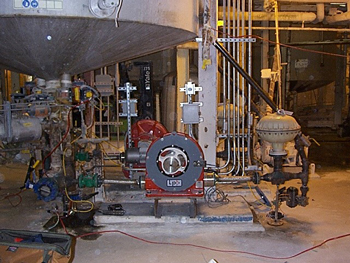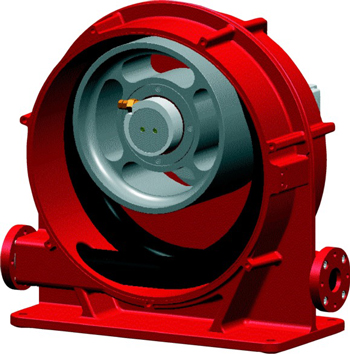Simple maintenance and the ability to clean in place give peristaltic pumps an advantage.
Many opportunities are available for peristaltic pump use in food and beverage applications. Peristaltic pumps are excellent for dosing or metering chemicals, liquid ingredients and flavorings. Transferring highly viscous solids from one location to another is also an ideal application for a peristaltic pump. Food slurries containing solid content or vegetable or fruit skins and waste are great applications for peristaltic pumps.
For instance, a potato processing plant uses peristaltic pumps to transfer ground potato skins and waste from one processing unit to another. The solid content of this slurry is approximately 70 percent. So once the material is in a peristaltic pump, it will push other material onward.
Since peristaltic pumps use positive displacement, they continue to produce pressure until the product moves through the pipeline. Any obstructions in the pipeline, even clogs, are overcome due to the positive displacement of these pumps. If bridging material clogs the suction side of the pump, it will create nearly a full vacuum to pull material inside. If the clog is stubborn and cannot be broken free by the suction capability alone, then the pump can simply be reversed to blow the obstruction free.
Peristaltic pumps have also been used to pump strawberries and live fish. The rolling action of the pump creates a wave of liquid that carries the solids (or live fish or strawberries, for example) through the pump without damaging them.
 |
| Two roller design peristaltic pumps in a waste treatment process in a food plant |
Cleaning
Most peristaltic pumps can run forward and backward simply by changing the direction of rotation. This is beneficial in applications that require CIP. One significant advantage of a peristaltic pump is its ability to clean in place (CIP).
When the pump is operating normally in one direction, a cleaning solution can be flushed through the hose in the opposite pumping direction to clean both the pump and upstream piping. Some peristaltic pumps have the ability to pump at the same discharge pressure in both directions and some do not, so it is important to talk to the manufacturer to determine if they have this ability.
The only component of the peristaltic pump that comes in contact with the flowing medium is the rubber hose or tube and their respective fittings that are inserted inside. The fittings are usually 316 stainless steel or another type of thermoplastic such as Kynar. Of course these fittings create a minor transition, so if the process must be ultra pure, then the peristaltic pump may not be the ideal choice. The ability to simply reverse the rotation of the pump and flush the pump with a cleaning solution is advantageous to many food applications.
Maintenance and Lubrication
Peristaltic pumps containing rubber hoses use glycerin to lubricate and in some designs to dissipate heat. The glycerin is contained in the pump housing and it never comes in contact with the pumped medium unless there is a hose failure, which will eventually occur. This glycerin can be a 99.5 kosher glycerin for food applications.
Both tube and hose peristaltic pumps are available. Tube pumps use thermoplastic tube materials such as Norprene or Tygothane. Peristaltic pumps that have these thermoplastic tubes typically do not use glycerin for lubrication or heat dissipation, so there is no risk of contamination. In many cases, peristaltic pumps that use thermoplastic tubing are relatively small diameter pumps that have limited pumping discharge pressures of about 30 to 125 psig, depending on manufacturer and tube material.
The rubber hoses in peristaltic pumps typically have burst pressures that exceed 600 psig and have continuous pumping pressure capabilities up to 150 psig or greater. Peristaltic pumps with rubber hoses typically do use glycerin for either lubrication or heat dissipation or both. The lifetime of rubber hoses in most pumping applications far exceeds the tube lifetime that peristaltic pumps can achieve with thermoplastic tubes. Hose lifetime can be five to 10 times longer with a rubber hose compared to a thermoplastic tube.
There are many reasons for this variation. The number one factor that determines how long a hose or tube will survive is how many times the hose is compressed. Many consumers think that the largest determining factor of hose life is the medium passing through the pump. However, this is not the case. A greater determination of hose life is the number of times the hose or tube is compressed.
A hose pump that places the least amount of compressions on the hose or tube will be the best choice. Many hose pump manufacturers use two rubbing shoes or two rollers to compress the hose twice every 360-degree revolution. Newer designs use an eccentric shaft and roller that compress the tube or hose only once per 360-degree revolution. Single compression per revolution devices will produce at a minimum twice the hose life versus shoe designs with two or more rollers. Because the single roller design creates less friction and heat, the life of the hose or tube is often four to five times longer than two or more shoe or multiple roller designs. The savings in maintenance and operational costs of a single roller design compared to multiple shoe or roller designs is often just as much as the cost of a new pump every year. When choosing a peristaltic pump, choose wisely. Operation and maintenance costs can vary widely from one manufacturer and designs to another.
A multiple shoe design peristaltic pump creates significant friction and also compresses the hose twice per revolution. Figure 1 represents a single rolling design peristaltic pump which compresses the rubber hose once per revolution allowing for the longest hose life.
 |
| Figure 1: Single shoe peristaltic pump |
Peristaltic Pump Limitations
Peristaltic pumps do have one significant limitation: the temperature capability of the rubber hose or tube. The maximum continuous temperature limitation of most hose materials is approximately 200 degrees F. However, many rubber materials can withstand much higher temperatures as long as the exposure is short in duration. So if there is a requirement for steam in place (SIP), a peristaltic pump may or may not be able to survive this cleaning and the rubber hose/tube material will dictate whether SIP is possible. It may be possible to SIP by using low pressure steam (approximately30 psig) for short durations (10 to 15 minutes). It would be advantageous to contact the manufacturer to determine if it recommends SIP with its pumps. If the SIP process requires longer SIP durations or higher pressure steam, then perhaps the peristaltic pump may not be the ideal pumping technology.
Conclusion
Peristaltic pumps have been very successful within the food and beverage industry in a multitude of applications. They are very efficient and easy to maintain and offer some benefits such as CIP and forward and reverse pumping direction to help in cleaning of upstream piping and instrumentation.
In general, the maintenance on peristaltic pumps is extremely easy. In 99 percent of instances, the maintenance required is simply replacing a failed tube or hose. This process usually takes less than one hour to complete and in some designs only minutes. The peristaltic pump may be your best choice for food and beverage applications depending on your process and needs.
| Food and Beverage Applications that Use Peristaltic Pumps The list of applications where peristaltic pumps have been used in the food and beverage industry is quite extensive. Below is a list of some applications in which peristaltic pumps have been successfully used. |
|
|

